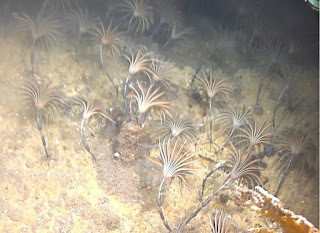The most spectacular tows have been those comprising the Feature of Conservation Importance habitat Coral Gardens. These have shown us a variety of coral species from bamboo corals Isididae, antipatharians (black corals) to scleractinians (hard corals). The scleractinians have mainly been Madrepora oculata, with some Lophelia pertusa. Bamboo corals are named for their stems which have a ‘joint-like’ appearance similar to bamboo. We’ve seen the bamboo coral Lepidisis sp., amongst others, and the antipatharian Stichopathes sp., an orange coral with a spring-like coil morphology. We’ve also seen beautiful fan-shaped gorgonian corals and the aptly-named bubblegum coral Paragorgia sp.. Although much rarer, there have been a few sponges, mainly encrusting on rocks and boulders, but also what we think may be Phakellia sp., and a Hexactinellid glass sponge.
 |
| Glass sponge and gorgonians |
 |
| Phakellia sp and Paragorgia sp |
 |
| Madrepora oculata and Lepidisis sp |
 |
| Acanella sp |
 |
| Stalked crinoids |
 |
| Stichopathes sp |